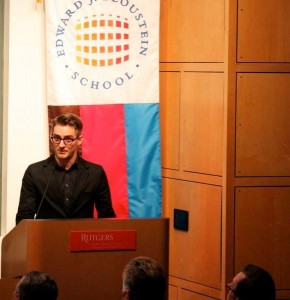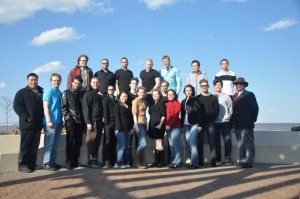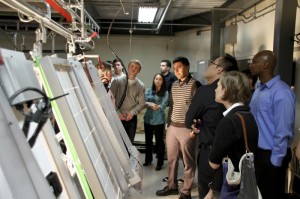Team New Jersey’s Beach House Approaches Sustainable Design From a Different Angle
Thursday, April 28, 2011By Erin Pierce
Editor’s Note: This entry has been cross-posted from DOE’s Energy Blog.
In honor of the U.S. Department of Energy Solar Decathlon—which challenges 20 collegiate teams to design, build, and operate solar-powered houses that are cost-effective, energy-efficient, and attractive—we are profiling each of the 20 teams participating in the competition.
When it comes to picturing a beach house, you typically picture large windows to let in fresh air and sunlight or wide porches to connect the home to the outdoors. What probably doesn’t come to mind is a home primarily made of precast concrete. However, Team New Jersey is doing exactly that—incorporating the age-old technology of concrete into its beach house design. The team hopes to show others how a material often seen as cold or industrial can be used for residential applications.

Jordan Tait (Courtesy of Team New Jersey)
The New Jersey Solar Decathlon team is a collaboration between two universities, Rutgers and the New Jersey Institute of Technology (NJIT).
“Rutgers is taking care of the engineering side of things, and we’re doing architecture. We’re learning together how the whole process pans out,” said NJIT student and Project Architecture Manager Jordan Tait.
New Jersey is the first team in the Solar Decathlon competition to use pre-cast concrete panels as its primary construction material. What is the reason? Jordan explained that several factors make concrete an ideal choice. For one, the panels are super insulated—composed of insulation sandwiched between 3 to 4 inches of poured concrete on either side.

Team New Jersey (Courtesy of Team New Jersey)
Also, the pre-cast concrete contributes to the house’s high thermal mass, which helps to avoid dramatic temperature fluctuations by retaining heat in the winter and keeping the house cool in the summer.
“It’s low-maintenance, sustainable, and green,” said Jordan.
Several other technologies will be incorporated into the design for optimal energy efficiency:
- The roof will take on an inverted hip shape—calibrated for maximum solar and rainwater collection.
- A 38-panel array will provide renewable energy for the house.
- Operable windows will allow for natural ventilation.
This Saturday, the team will have a chance to showcase its design to a wider audience.
“A lot of people think the shape is very dynamic. They’re very interested to see it done and built,” said Jordan.
At Rutgers Day, an event for prospective students and their families, visitors will see a digital walkthrough of the house and get a chance to see some of the building materials up close.

Student team members view solar panels (Courtesy of Team New Jersey)
As the competition draws nearer, it’s clear that Jordan and his fellow teammates have gained a lot from the demanding experience.
“There’s a bigger spectrum of things to learn than just the academic scope,” said Jordan. “By coordinating with contractors, engineers, and consultants, we’re picking up different skill sets. We’re really taking the project far above and beyond the call of duty.”
Visit the Team New Jersey website and Facebook page for more about its journey to the Solar Decathlon competition.
Erin Pierce is an energy technology program specialist for the Office of Energy Efficiency and Renewable Energy.
Tags: Solar Decathlon, Solar Decathlon 2011, Team New Jersey, Teams
